
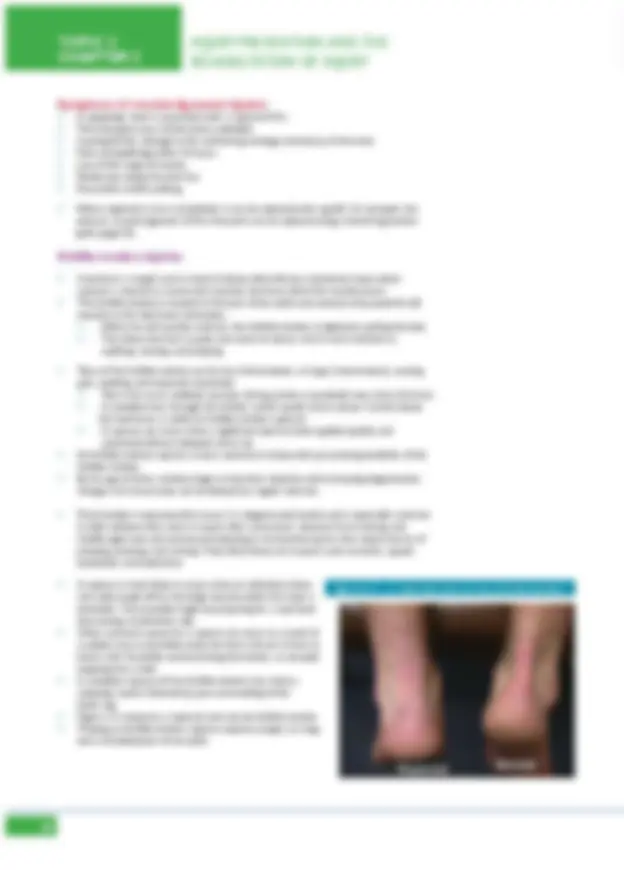
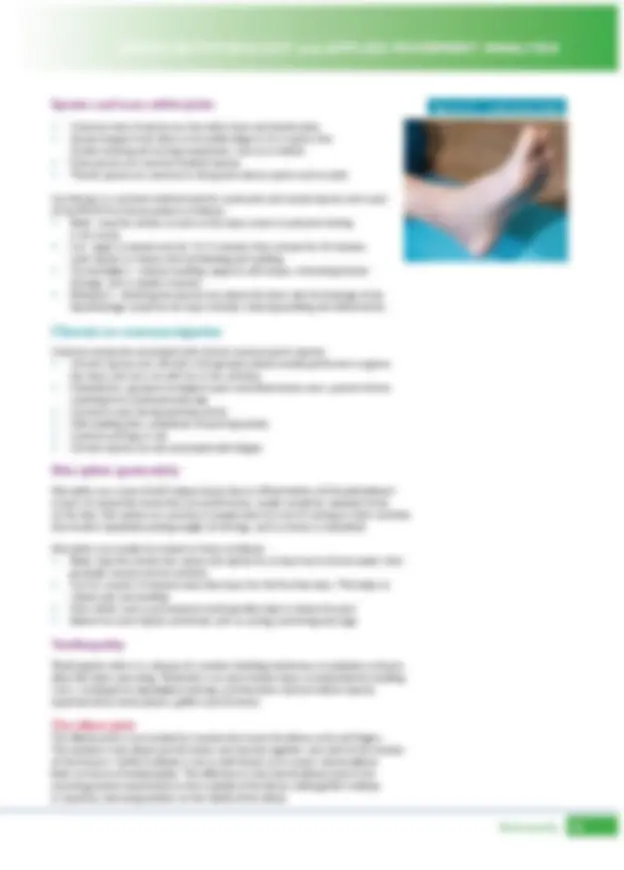
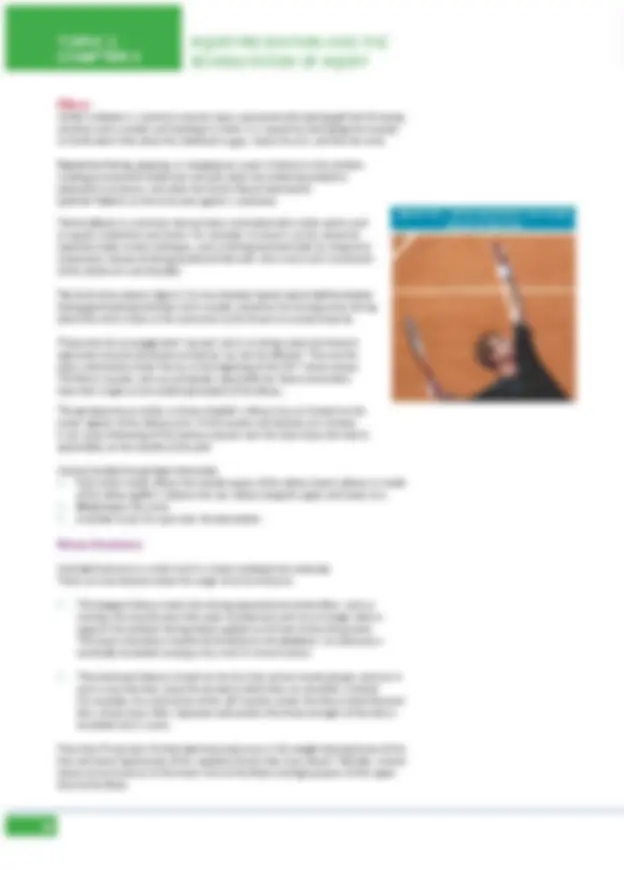
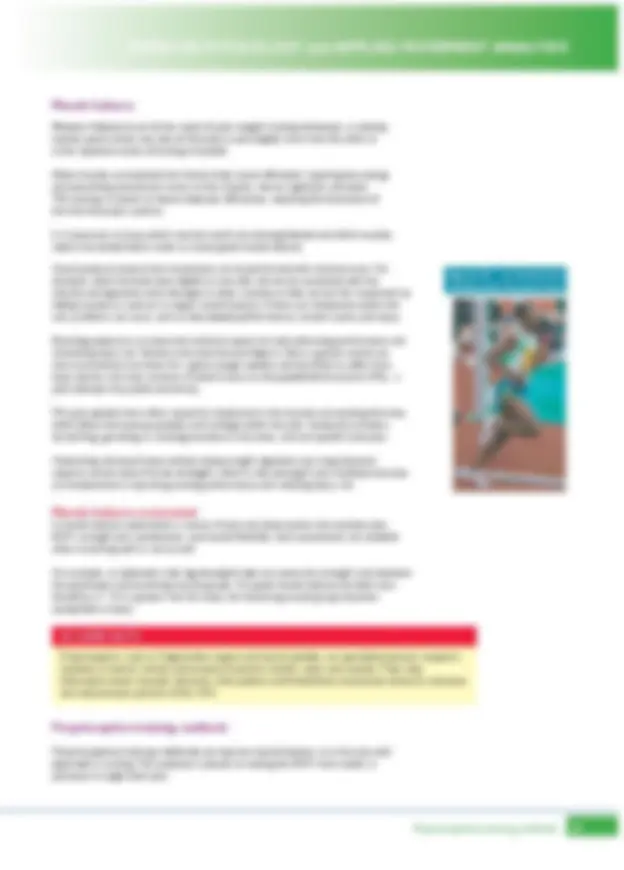
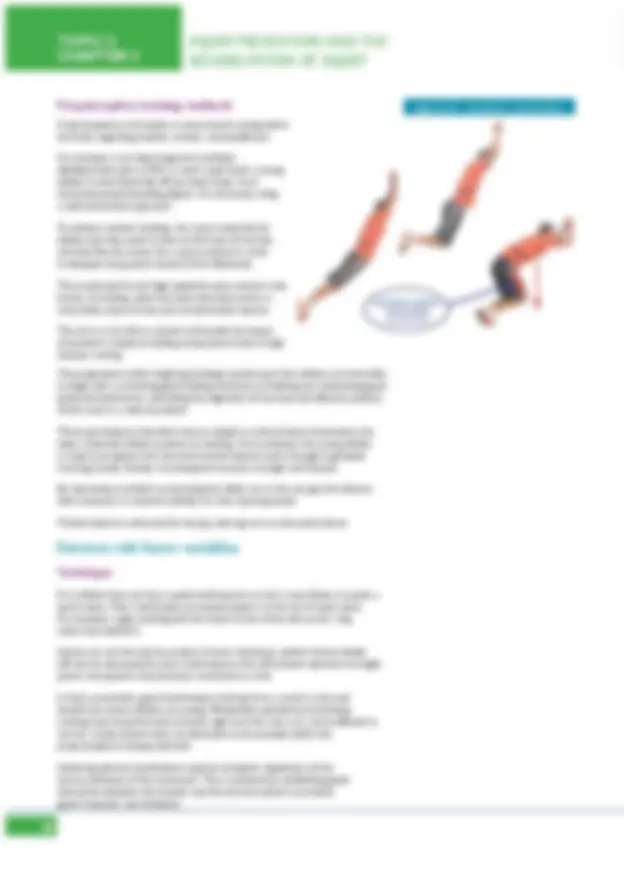
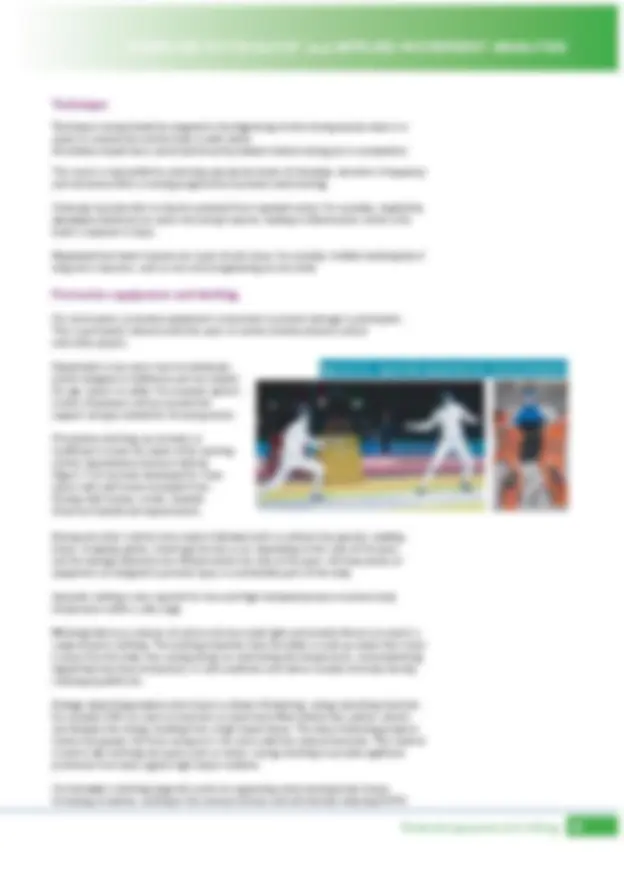
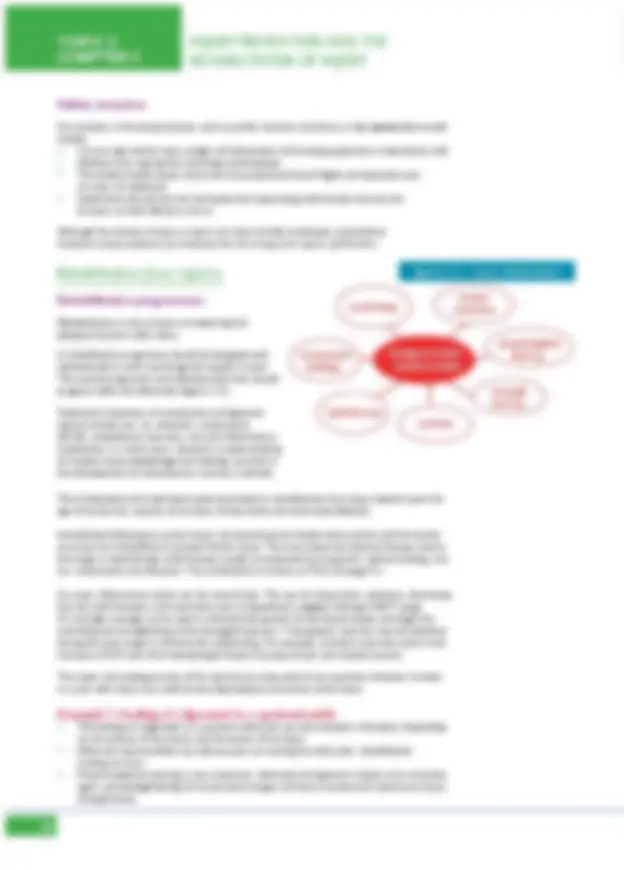
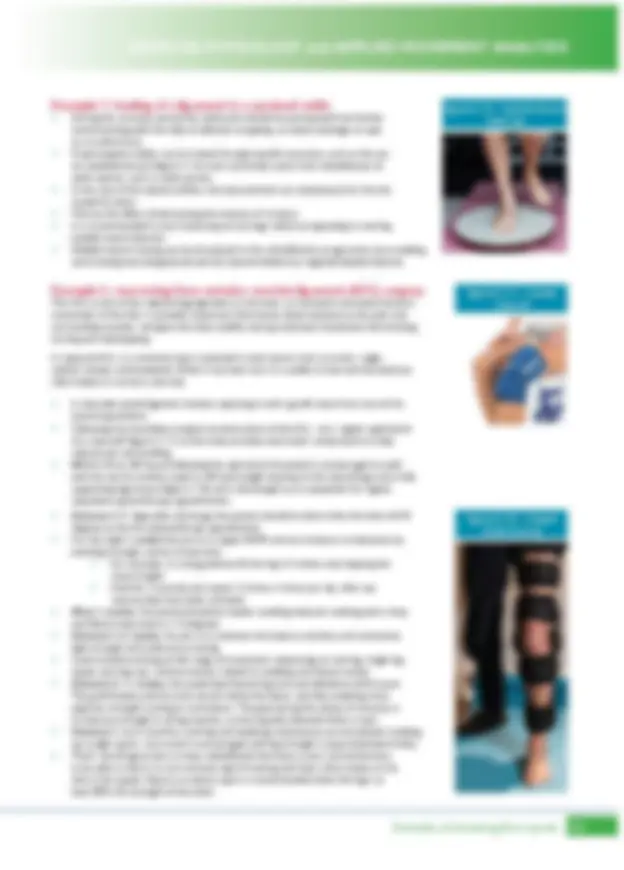
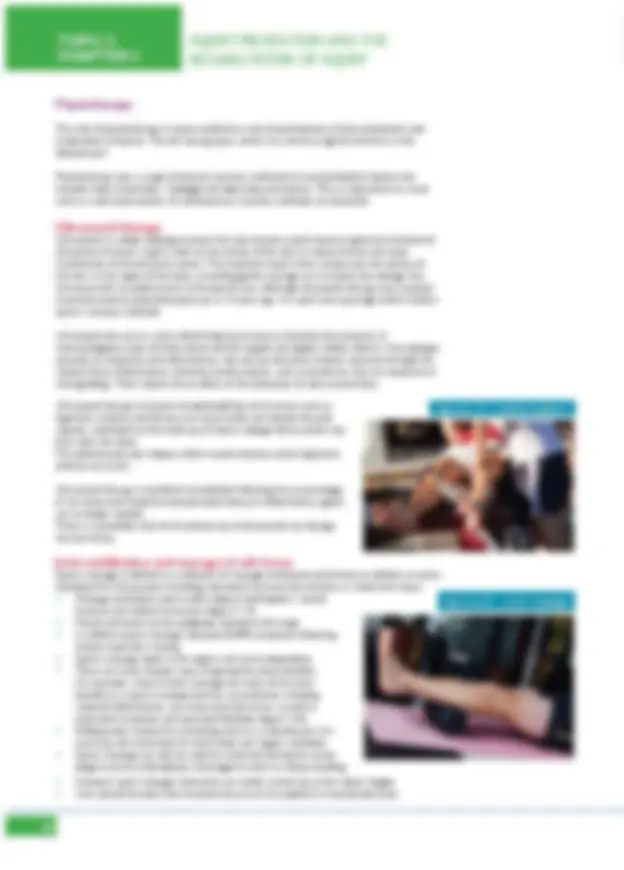
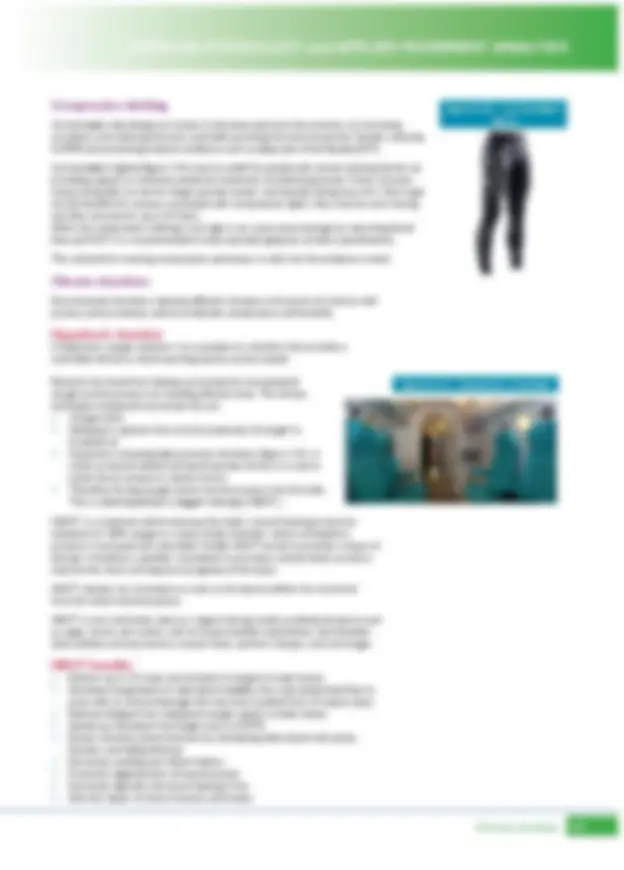
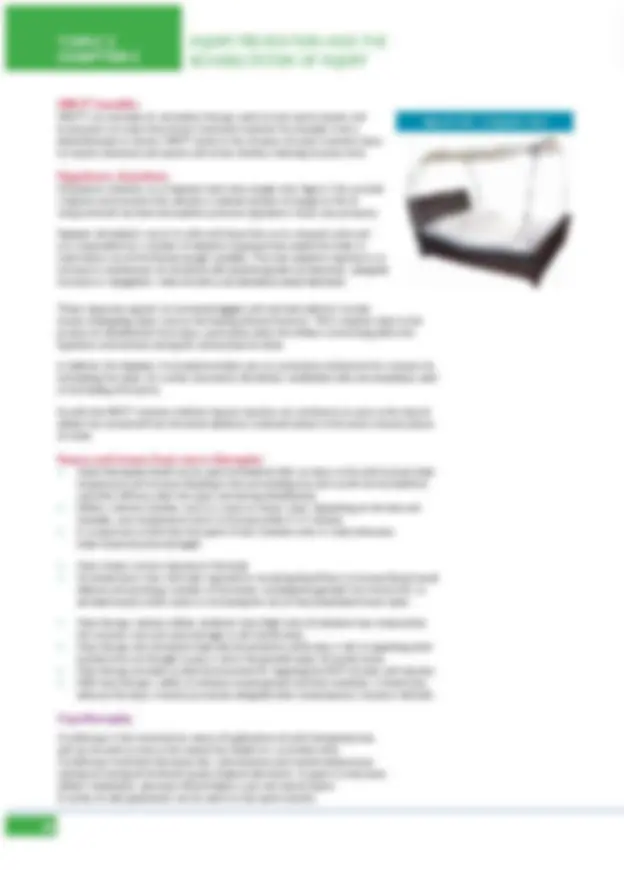

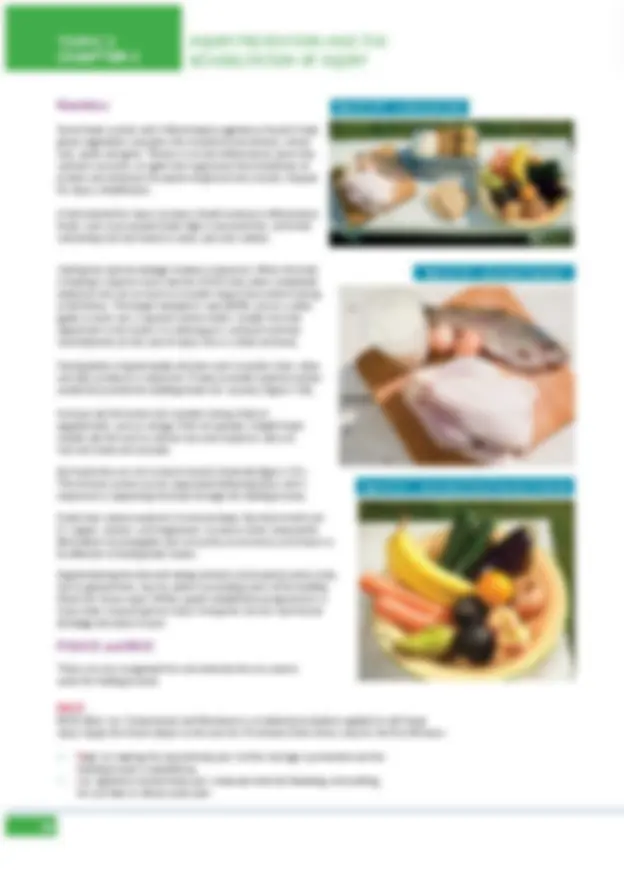
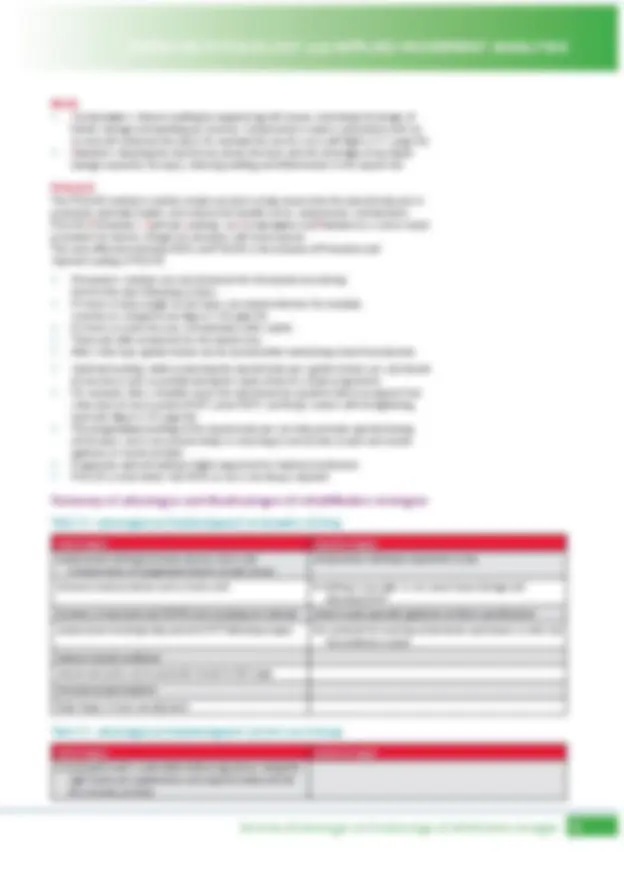
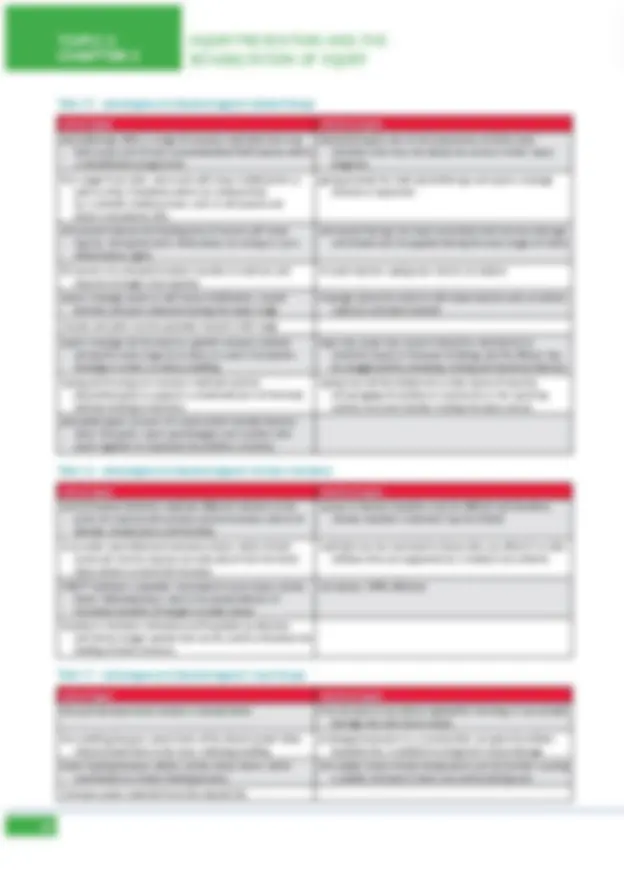
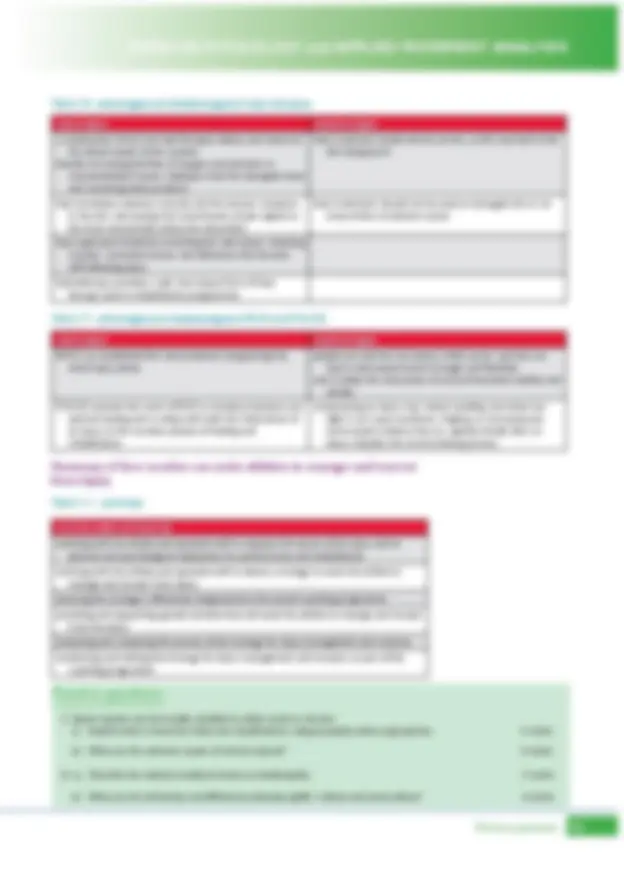



Study with the several resources on Docsity

Earn points by helping other students or get them with a premium plan


Prepare for your exams
Study with the several resources on Docsity

Earn points to download
Earn points by helping other students or get them with a premium plan
Community
Ask the community for help and clear up your study doubts
Discover the best universities in your country according to Docsity users
Free resources
Download our free guides on studying techniques, anxiety management strategies, and thesis advice from Docsity tutors
Characterised by pain, swelling, tenderness, weakness and the inability to use or place weight on the injured area. •. Acute injuries refer to sports injuries ...
Typology: Schemes and Mind Maps
1 / 25

This page cannot be seen from the preview
Don't miss anything!


















causes of injury
prevention of injury
rehabilitation after injury
acute injuries
chronic injuries
A sports injury is any kind of injury, pain or physical damage that occurs as a result of sport, exercise or physical activity.
Sports injuries are unfortunately inevitable, and are dependent on a performer’s intensity of training, the preparation he or she makes to avoid injury, and the ways in which rest and recovery are planned into a training and competitive programme. Figure 2.1 outlines the factors influencing how injuries are caused and can be dealt with.
Sports injuries are:
Common symptoms associated with acute sports injuries:
A bone fracture is a break in the bone and is caused by excessive external forces and so is classified as traumatic fracture. There are two major classes:
A dislocation occurs when the bones which meet at a joint, are separated by a violent action so that the joint no longer functions.
EXERCISE PHYSIOLOGY and APPLIED MOVEMENT ANALYSIS
Common soft tissue injuries
A soft tissue injury occurs when muscles , ligaments and tendons are damaged. Common soft tissue injuries usually occur from a sprain, a strain or a one off blow resulting in a contusion or bruise (caused when blood vessels are damaged or broken as the result of a blow to the skin). Contusions are common in contact sports such as rugby and boxing. Soft tissue injuries can result in pain, swelling, bruising and loss of function.
figure 2.3 – a complete ACL tear
There are three graded categories for all ligament injuries:
Grade 1 sprain : the ligament is mildly damaged as it has been slightly stretched, but is still able to help keep the knee joint stable. Grade 2 sprain : the ligament is stretched to a point where it becomes loose, and is commonly known as a partial tear of the ligament. Grade 3 sprain : a complete tear of the ligament into two pieces. For example, a complete tear of the ACL creating an unstable knee joint (figure 2.3).
A complete rupture leads to mechanical instability, whilst tearing may damage the proprioceptive feedbak mechanism.
The ACL can be injured in several ways:
EXERCISE PHYSIOLOGY and APPLIED MOVEMENT ANALYSIS
Ice therapy is a common method used for acute joint and muscle injuries and is part of the RICE First Aid procedure as follows:
Chronic or overuse injuries
Common symptoms associated with chronic overuse sports injuries:
Shin splints are a type of soft tissue injury due to inflammation of the periosteum (a layer of connective tissue that surrounds bone), usually caused by repeated stress on the tibia. Shin splints are common in people who do a lot of running or other activities that involve repeatedly putting weight on the legs, such as tennis or basketball.
Shin splints can usually be treated at home as follows:
Tendinopathy refers to a disease of a tendon including tenderness on palpation and pain, often felt when exercising. Tendonitis is an acute tendon injury accompanied by swelling (‘itis’), resulting from excessive overuse , and describes common elbow injuries, experienced by tennis players, golfers and throwers.
The elbow joint is surrounded by muscles that move the elbow, wrist and fingers. The tendons in the elbow join the bones and muscles together, and control the muscles of the forearm. Golfer’s elbow is not as well known as its cousin, tennis elbow. Both are forms of tendinopathy. The difference is that tennis elbow stems from overusing tendon attachments to the outside of the elbow, while golfer’s elbow is caused by overusing tendons on the inside of the elbow.
EXERCISE PHYSIOLOGY and APPLIED MOVEMENT ANALYSIS
Golfer’s elbow is a common overuse injury associated with playing golf and throwing activities such as javelin and bowling in cricket. It is caused by overusing the muscles in the forearm that allow the individual to grip, rotate the arm, and flex the wrist.
Repetitive flexing, gripping, or swinging can cause irritations to the tendons creating pronounced tenderness and pain when the medial epicondyle is subjected to pressure, and when the hand is flexed downwards ( palmer flexion ) at the wrist joint against a resistance. figure 2.6 – wrist supination can cause Tennis elbow is a common overuse injury associated with racket sports such elbow tondonitis as squash, badminton and tennis. For example, in tennis it can be caused by repetitive faulty stroke technique, such as hitting backhand balls by using wrist movements instead of hitting backhand balls with a firm wrist and a movement of the whole arm and shoulder.
Top level tennis players (figure 2.6) may develop lateral epicondylitis despite having good playing technique and is usually caused by the serving action during which the wrist is bent at the same time as the forearm is turned inwards.
Those who hit an exaggerated ‘top spin’ and in so doing rotate the forearm vigorously inwards (excessive pronation) can also be affected. This was the injury sustained by Andy Murray at the beginning of the 2017 tennis season. The flexor muscles, that are principally responsible for these movements, have their origins at the medial epicondyle of the elbow.
The symptoms are similar to those of golfer’s elbow, but are located on the outer aspect of the elbow joint. If the muscles and tendons are irritated, it can cause thickening of the tendon and pain near the bony lump (the lateral epicondyle) on the outside of the joint.
General tendonitis symptoms include:
A stress fracture is a small crack in a bone resulting from overuse. There are two theories about the origin of stress fractures:
More than 50 percent of all stress fractures occur in the weight-bearing bones of the foot and lower leg because of the repetitive forces they must absorb. Typically, runners sustain stress fractures of the lower third of the fibula and high jumpers of the upper third of the fibula.
INJURY PREVENTION AND THE
REHABILITATION OF INJURY
TOPIC 2 CHAPTER 2
figure 2.7 – the plank
A core stability conditioning programme benefits good muscle balance and coordination (figure 2.7). Good core stability involves the effective recruitment of the muscles that stabilise the lumbo- pelvic-hip complex , together with those that stabilise the shoulder girdle. Many athletes attend pilates , a body-conditioning technique that concentrates on strengthening the core postural muscles needed by all active sportspersons.
Variance in training avoids the overuse injuries associated with using the same exercises and movements year round, and builds the right foundation for achieving peak performance at the right time.
All training/competitive activities should begin with a warm-up. A warm-up takes the body from a non-active state to one ready for exercise. The absence of a warm-up or an inadequate warm-up is a common cause of injury.
Lack of flexibility can limit range of movement (ROM) and lead to sprain and strain injuries. Hyper-mobility enables joints to move beyond the normal range expected for that particular joint and can lead to poor joint stability and dislocations.
A cool-down gradually returns the body to its former resting state with reduced injury risk. A major physiological value of an active cool-down is to flush out lactic acid thereby preventing muscle soreness ( DOMS ).
Sport performers require sports specific training programmes aimed at developing those muscle fibres which are used most intensively in competition. These programmes should include a variety of skills, drills and techniques that should mimic the desired sporting action as closely as possible.
For reviews of antagonistic muscle action, warm-up, cool-down and preparation and training methods refer to AS/A 1 Edexcel ISBN 978190142488, Chapter 1 , page 25, Chapter 2, page 32, Chapter 8, page 121 and Chapter 7, page 87 respectively.
Human movement and function requires a balance of muscle length and strength between opposing muscles surrounding a joint. Normal amounts of opposing force between muscles are necessary to keep the bones centred in the joint during motion, to create muscle balance.
Muscle imbalance occurs when opposing muscles provide different directions of tension due to tightness and/or weakness. When a muscle is too tight, the joint tends to move in that direction and is limited in the opposite direction since this is typically the path of least resistance.
There are also two recognised causes of muscle imbalance :
Muscle imbalances can be characterised by either side-to-side (right versus left) or front-to- back (agonist versus antagonist) differences in muscle length or strength. Most musculoskeletal pain syndromes are caused by front-to-back differences, or imbalances of muscles surrounding a joint, rather than side-to-side differences (in the frontal plane).
For example, the quadriceps and hamstrings of the knee joint perform opposite motion (antagonistic pairing), and so an imbalance between the two could put undue stress on the knee joint. A tight hamstring would not allow the joint to glide normally or fully extend, which could put extra stress on the quadriceps muscle and patella (knee cap) tendon.
INJURY PREVENTION AND THE
REHABILITATION OF INJURY
TOPIC 2 CHAPTER 2
EXERCISE PHYSIOLOGY and APPLIED MOVEMENT ANALYSIS
Muscle imbalance can be the result of poor weight training techniques, or playing intense sports where one side of the body is used slightly more than the other as in the repetitive action of kicking in football.
When muscles are balanced the human body moves efficiently, requiring less energy and preventing unnecessary stress on the muscles, nerves, ligaments and joints. This synergy is known as neuromuscular efficiency , requiring the interaction of the neuromuscular systems.
It is important to know which muscles need to be strengthened and which muscles need to be stretched in order to create good muscle balance.
figure A.3 - an endurance athlete keeps going for a long t
figure 2.8 – an endurance athlete with forward lean
Good posture ensures that movements can be performed with minimal strain. For example, when the body leans slightly to one side, the nerves associated with the muscles and ligaments send messages to other muscles to help correct this movement by telling muscles to contract to regain muscle balance. If there are imbalances within this unit, problems can occur, such as decreased performance , muscle trauma and injury.
Running posture is an important technical aspect for both enhancing performance and minimising injury risk. Runners who lean forward (figure 2.8) to a greater extent are more economical (run faster for a given oxygen uptake) and less likely to suffer from knee injuries, the most common of which occurs at the patellofemoral joint (PFJ) - a joint between the patella and femur).
PFJ pain syndrome is often caused by imbalances in the muscles surrounding the knee, which affect the kneecap (patella) and cartilage within the joint. Symptoms include a scratching , grinding or clicking sensation in the knee, and non-specific knee pain.
Maintaining a forward lean without losing straight alignment over long distances requires certain level of torso strength , which is why strength and mobility exercises are fundamental in improving running performance and reducing injury risk.
A muscle balance assessment is a series of tests and observations that evaluate joint ROM, strength and coordination, and muscle flexibility. Such assessments can establish what is working well or not so well.
For example, an isokinetic lido leg strength test can assess the strength ratio between the quadriceps and hamstring muscle groups. For good muscle balance the ideal ratio should be 2: 1. If it is greater that this value, the hamstring muscle group becomes susceptible to injury.
Proprioceptors, such as Golgi tendon organs and muscle spindles, are specialised sensory receptors sensitive to stretch, tension and pressure located in tendon, joints and muscles. They relay information about muscular dynamics, limb position and kinaesthesia (movement sense) to conscious and subconscious portions of the CNS.
Proprioceptive training methods can improve muscle balance, as is the case with plyometric training. The emphasis is placed on making the ROM more stable, in particular in single limb tasks.
EXERCISE PHYSIOLOGY and APPLIED MOVEMENT ANALYSIS
Technique training should be assigned to the beginning of the training session when it is easier to concentrate and the body is well-rested. All athletes should have a solid technical foundation before taking part in competition.
The coach is responsible for planning appropriate levels of intensity , duration , frequency and variance within a training programme to prevent overtraining.
Overuse injuries refer to injuries sustained from repeated action. For example, repetitive , excessive overload can cause microscopic injuries, leading to inflammation, which is the body’s response to injury.
Repeated low level impacts can cause chronic injury, for example, Achilles tendinopathy if long-term measures, such as rest and strengthening are not taken.
For some sports, protective equipment is important to prevent damage to participants. This is particularly relevant when the sport or activity involves physical contact with other players.
Equipment in any sport may be inadequate, figure 2.10 – specialist equipment for injury prevention poorly designed or ineffective and not suitable for age, stature or ability. For example, generic trainers (footwear) will not provide the support and grip needed for throwing events.
Protective clothing can be faulty or insufficient to meet the needs of the sporting activity. Specialised protective clothing (figure 2.10) has been developed for many sports with well known examples from fencing, field hockey, cricket, baseball, American football and equestrianism.
Boxing and other martial arts require helmets (with or without face guards), padding, boxes, strapping, gloves, mouth guards and so on, depending on the rules of the sport, and the damage allowed to be inflicted within the rules of the sport. All these pieces of equipment are designed to prevent injury to vulnerable parts of the body.
Specialist clothing is also required for low and high temperatures to maintain body temperature within a safe range.
Wicking fabrics (a mixture of cotton and man-made light and stretchy fibres) are used in a range of sports clothing. The wicking properties have the ability to soak up sweat then move it away from the body, thus saving energy on maintaining skin temperature, and preventing hyperthermia (heat exhaustion). In cold conditions such fabrics insulate the body thereby reducing hypothermia.
Energy absorbing plastics (also known as shear-thickening , energy absorbing materials, for example D30) are used as materials to create foam-filled clothes that cushion, absorb and dissipate the energy resulting from a high impact blows. The shear-thickening property means that greater the force acting on it, the more solid the material becomes. This material is used in ski clothing and sports such as motor racing clothing to provide significant protection from injury against high impact incidents.
Compression clothing (page 46) works by supporting and protecting body tissues, increasing circulation, assisting in the removal of lactic acid and thereby reducing DOMS.
EXERCISE PHYSIOLOGY and APPLIED MOVEMENT ANALYSIS
figure 2.11 – Dan Hipkiss - with specially moulded shoes
Sports footwear is the most important item of equipment for most sports. When choosing sports footwear, several factors must be taken into consideration including the sport involved and the surface used.
For example, in long-distance running the weight of the shoes can be of importance. They should not, however, be so light that their stability is impaired.
Elite athletes are often provided with bespoke footwear. The foot is scanned to capture its shape, then footfall is analysed (using forceplate technology). This indicates how the foot lands and moves and leads to the development of personalised footwear, whose aim is to make movement more efficient, improve performance and reduce the likelihood of injury (figure 2.11).
Proper fitting and sport-specific footwear reduce the risk of injury to the soft tissues, bones or joints of the lower limb.
The risk of a sprained ankle and other such injuries has been shown to significantly be reduced by wearing braces such as ankle supports (as worn by tennis star Andy Murray - figure 2.12).
There are a few items that can be used in training, but not allowed in competitive figure 2.12 – ankle bracing situations. For example, strapping a shot putter’s fingers or hand helps prevent finger knuckle sprains, but is not allowed in competition.
There are many other examples of protective equipment, all of which contribute in the prevention of sports injuries.
A hazard is something that is potentially dangerous to an individual or activity or both. For example, if a sports hall roof leaks the floor may become wet and so it will need to be coned off and dried to prevent people slipping during a physical activity.
Temperature , wet and windy conditions can also be responsible for injury, and particularly cyclists should take care when cycling on wet, greasy roads.
The ability to perform vigorous exercise for long periods is limited by hyperthermia (over heating) and loss of water and salt in sweating. Athletes should know the hazards of vigorous exercise in hot, humid conditions particularly in ultra endurance events, and should be able to recognise the early warning symptoms that precede heat injury.
Managing risks refers to the practice of identifying potential risks in advance, analysing them and taking precautionary steps to reduce/curb the risk. This is known as a risk assessment.
Injury prevention and management is an important component of a coaching programme for participants in many sports and activities. An important function of a coach is to identify , evaluate and refine an injury risk coaching strategy programme for everyone in the coaching group, in addition to managing injury recovery strategies.
Coaches must also take account of guidelines and assessment opportunities from national governing bodies, experts and their own prior experience when designing and delivering injury prevention and management strategies.
INJURY PREVENTION AND THE
REHABILITATION OF INJURY
TOPIC 2 CHAPTER 2
For example, in throwing activities, such as javelin, hammer and discus a risk assessment would include:
Although the chances of injury in sport can never be fully eradicated, preventative measures and procedures can minimise the risk of injury for sports’ performers.
Rehabilitation from injuries^ figure 2.15 – injury rehabilitation
Rehabilitation is the process of restoring full physical function after injury.
A rehabilitation programme should be designed with individual short-term and long-term goals in mind. The overall programme and individual exercises should progress safely and effectively (figure 2.15).
Traditional treatments of muscle/joint and ligaments injuries include rest, ice, elevation, compression ( RICE ), rehabilitation exercises, and anti-inflammatory medications. In recent years, advances in understanding of muscle injury physiology and healing , have led to the development of contemporary recovery methods.
The timescales and treatment options involved in rehabilitation from injury depend upon the age of the person, severity of the injury, fitness levels and active daily lifestyles.
Immediately following an acute injury , the injured person should cease activity and the injured area must be immobilised to prevent further injury. The most important physical therapy used at this stage is cryotherapy (cold therapy) usually accompanied by protection, optimal loading, rest, ice, compression and elevation. This combination is known as POLICE (page 51).
An acute, inflammatory phase can last several days. The use of compression, elevation, alternating hot and cold therapies, and treatments such as hyperbaric oxygen therapy HBOT (page
The repair and healing process of the injured area takes place from anywhere between 3 weeks to a year after injury, but could be less depending on the extent of the injury.
INJURY PREVENTION AND THE
REHABILITATION OF INJURY
TOPIC 2 CHAPTER 2
EXERCISE PHYSIOLOGY and APPLIED MOVEMENT ANALYSIS
figure 2.16 – wobble board exercise
figure 2.17 – a knee cryocuff
The ACL is one of the restraining ligaments in the knee, as it prevents excessive forward movement of the tibia. It provides important information about balance to the joint and surrounding muscles, and gives the knee stability during rotational movements like twisting, turning and sidestepping.
A ruptured ACL is a common injury sustained in team sports such as soccer, rugby, netball, hockey and basketball. When it has been torn it is unable to heal and the balance information it carries is also lost.
EXERCISE PHYSIOLOGY and APPLIED MOVEMENT ANALYSIS
Electro stimulation (ES) also known as neuromuscular electrical stimulation (NMES), is a training technique used for injury prevention, injury treatment, toning, pain relief, muscular recovery and physical preparation.
Electrodes are placed on the muscle groups such as the abdominal muscles, hamstrings (figure 2.21), calf muscles, plantar arch muscles and lower back muscles. An electric current is produced which is sent to the nerve fibres causing a mechanical response in the muscle. The current settings can vary depending on the clinical pathology requirements.
ES is thought to affect the body with associated therapeutic benefits that:
One of the major detraining effects that occur during long-term injuries is figure 2.22 – the plank muscular atrophy of the unused limb. It is therefore essential that these particular muscles increase their size back to normal. Within the early stages of muscle rehabilitation, muscular size can be increased by effective electrical stimulation to the muscle.
Core stability exercises should not be neglected and can be combined with the start of performing some more traditional weight training exercises. The plank (figure 2.22 and figure 2.7, page 36) is one of the best body weight training exercises for improving core conditioning (which is often compromised following injury) but it also works gluteal and hamstring muscle groups, supports posture and improves balance.
As soon as the injured athlete can tolerate increased loading, he can progress through his rehab process back into more traditional strength and conditioning training programmes. For example, free squats can progress to single leg squats.
Strengthening the quadriceps and hamstrings will directly result in increased stability of the knee joint and in turn further reduce the reoccurrence of hamstring injuries such as tears. During this period, the injured athlete will start to benefit from anatomical adaptations, such as muscular hypertrophy as he or she gradually progresses to pre-injury strength levels.
Elastic resistance is a unique type of resistance training that can be safely used in injury rehabilitation. The resistance provided by the latex elastic band or tubing is based on the amount that the band or tubing is stretched. Thera Band (a brand name for a type of elastic band of varying strength) elastic resistance training increases strength, mobility and muscle function, as well as reducing joint pain.
For example, following a shoulder injury, the main focus is to increase the range of movement and muscle strength , especially the rotator cuff which is a group of muscles that rotate the arm (figure 2.23).
Note that in this example the resistance is light, but sufficient to create the required adaptive physiological response.
The physiotherapist will include rest and active rest to give stressed body parts time to recover prior to the next part of the rehabilitation programme.
Compression clothing works by applying a constant pressure on the body part, which adds external pressure to the veins.
Compression clothing is also said to potentially enhance sporting performance by:
INJURY PREVENTION AND THE
REHABILITATION OF INJURY
TOPIC 2 CHAPTER 2
HBOT is an example of a secondary therapy used to treat sports injuries and figure 2.26 – a hypoxic tent its purpose is to assist the primary treatment received, for example, from a physiotherapist or doctor. HBOT assists in the recovery of acute traumatic injury to muscle contusions and sprains and strains thereby reducing recovery time.
A hypobaric chamber or an hypoxic tent (low oxygen tent, figure 2.26), provide a hypoxic environment that contains a reduced amount of oxygen in the air compared with sea level atmospheric pressure (hypobaric means low pressure).
Hypoxic simulation occurs in cells and tissues that are in a hypoxic state and so is responsible for a number of adaptive responses that enable the body to make better use of the limited oxygen available. The main adaptive response is an increase in manufacture of red blood cells ( erythropoietin production), alongside increases in myoglobin , mitochondria and oxidative enzymes levels.
These responses support an increased oxygen and nutrient delivery to body tissues undergoing repair, such as the healing of bone fractures. This is of great value to the process of rehabilitation from injury, particularly when the athlete is exercising within the hypobaric environment during the active phase of rehab.
In addition, this hypoxic microenvironment acts as a protective mechanism for recovery by stimulating the repair of a variety of proteins, fibroblasts, endothelial cells and osteoblasts used in the healing of fractures.
As with the HBOT recovery method, hypoxic sessions can commence as soon as the injured athlete has recovered from the initial sedentary treatment phase to the active recovery phase of rehab.
Cryotherapy is the treatment by means of applications of cold temperatures , and can be used as soon as the wound has healed (i.e. no broken skin). Cryotherapy treatment decreases skin, subcutaneous and muscle temperature, causing narrowing of the blood vessels ( vasoconstriction ). Its goal is to decrease cellular metabolism, decrease inflammation , pain and muscle spasm. A variety of cold applications can be used to treat sports injuries.
INJURY PREVENTION AND THE
REHABILITATION OF INJURY
TOPIC 2 CHAPTER 2
EXERCISE PHYSIOLOGY and APPLIED MOVEMENT ANALYSIS
WBC involves exposing individuals to extremely cold dry air (below -100°C) for two to four minutes in a cryogenic chamber. Reduction in skin and muscle tissue temperatures reduces blood flow to the arms and legs ( vasoconstriction ) and divert blood flow to the body’s central core.
On leaving the chamber, blood flow returns to the arms and legs ( vasodilation ) reinstating normal oxygen levels, thus aiding the healing process. WBC relieves muscle soreness and inflammation following high intensity training, as a result of reduced muscle metabolism, and is a popular recovery method used by professional sportspeople. WBC is a much quicker alternative to ice baths, but does require specialist expensive equipment.
Various alternative and cheaper cooling therapies are used in acute sports injuries as well as rehabilitation of the injured athlete, injury prevention and recovery from training and competitions. For example, ice packs, ice towels, ice massage and frozen gel packs.
Ice baths (figure 2.27) use the fact that chilling the affected area can reduce local inflammation. The ice bath is thought to constrict blood vessels, flush waste products such as lactic acid and reduce swelling and tissue breakdown.
Studies have shown that total cold water upright immersion (at an optimal temperature of 10 degrees and up to 10 minutes immersion) decreases inflammation following injury and aids recovery from training. The effect is best when the water pressure is greatest. In addition, it gives the athlete a feeling of perceived freshness.
Precautions should be taken because prolonged application of very low temperatures could have detrimental effects.
This is the alternating use of hot and cold application to an injured muscle or body part for therapeutic effect (for example, increasing blood flow to speed up the recovery process).
Hydrotherapy is a therapeutic whole-body treatment that involves moving and exercising in a warm water pool. The temperature, pressure and movement of water are controlled and changed according to who’s using the pool.
For example, aquajogging (figure 2.28) has proven to be a very good form of injury rehabilitation. This is because of its low impact on the muscles and the use of water resistance as an effective way of applying force to the lower limbs.
This combination avoids muscle soreness, stress fractures and aching joints and enables an injured athlete to maintain fitness during a rehabilitation programme. This method of hydrotherapy can be used as an alternative option to training on hard running surfaces, in addition to supporting recovery from hard impact training.
By choosing the right diet and supplements, recovery from injury can be enhanced. Eating a diet that achieves a the balance between allowing the immune system to function normally, whilst preventing the inflammatory response from becoming excessive, will speed up the process of rehabilitation from injury.